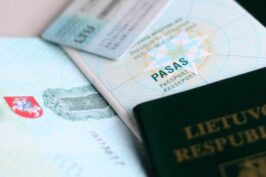- Home
- Lithuanian Citizens according to the Soviet-Lithuanian Peace Treaty of 12 July 1920
Lithuanian Citizens according to the Soviet-Lithuanian Peace Treaty of 12 July 1920


The Soviet-Lithuanian Peace Treaty of 12 July 1920 also provided for which persons were recognized as Lithuanian citizens.
It has been established in part 1 and 2 of Article 6 of the Soviet-Lithuanian Peace Treaty that:
“Persons who lived on the territory of Lithuania during the day of ratification of this Treaty and who themselves or their parents permanently lived in Lithuania or were registered in the village, town or caste communities in the territory of Lithuania, as well as persons who had been living in Lithuania for at least the last ten years before 1914, having the permanent job there, leaving former civilians and military servicemen, not of the Lithuanian descent, together with their families shall be ipso facto recognized as citizens of the state of Lithuania.
Persons of the same category who, while ratifying this Treaty, live in the territory of a third state but have not been naturalized there, are equally recognized as citizens of the state of Lithuania”.
Article 6 of the Soviet-Lithuanian Peace Treaty distinguished four categories of persons who were treated as citizens of Lithuania:
- persons who themselves or their parents permanently lived in Lithuania;
- persons who were recorded in village, town or caste communities in the territory of Lithuania;
- persons who have been living in Lithuania for at least the last ten years before 1914 and had the permanent job thereto;
- persons belonging to the abovementioned categories of persons who, when ratifying this Treaty, lived in the territory of a third country and have not acquired citizenship of that state by way of naturalization.
Persons referred to in Article 6 of the Soviet-Lithuanian Peace Treaty may have resided either in the territory of Lithuania or in the territory of a third state at the date of ratification of this Treaty.
Persons who lived in the territory of Lithuania were immediately considered to be Lithuanian citizens. Persons who lived in the territory of Russia were considered to be Lithuanian citizens only when they opted for Lithuanian citizenship under the conditions laid down in the Treaty. Persons who lived in the territory of a third state were considered to be Lithuanian citizens only if they were not naturalized in that country.
The Provisional Law on Lithuanian Citizenship and the Soviet-Lithuanian Peace Treaty were considered to be sources of law for citizenship.
MIGRATION LAW CENTER






























